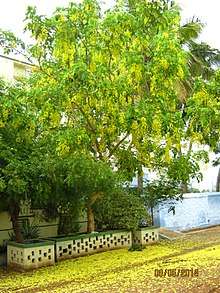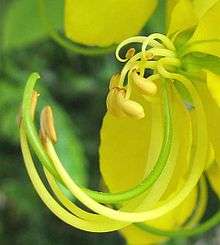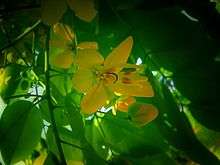Cassia fistula
| Indian Laburnum | |
|---|---|
| Golden shower tree in bloom | |
| Scientific classification | |
| Kingdom: | Plantae |
| (unranked): | Angiosperms |
| (unranked): | Eudicots |
| (unranked): | Rosids |
| Order: | Fabales |
| Family: | Fabaceae |
| Genus: | Cassia |
| Species: | C. fistula |
| Binomial name | |
| Cassia fistula | |
| Synonyms[1] | |
| |
Cassia fistula, known as the golden rain tree, canafistula and by other names, is a flowering plant in the family Fabaceae. The species is native to the Indian subcontinent and adjacent regions of Southeast Asia. It ranges from eastward throughout India to Myanmar and Thailand and south to Sri Lanka and southern Pakistan. It is the state flower of Kerala in India and of immense importance amongst the Malayali population. It is a popular ornamental plant and is also used in herbal medicine. In ancient Tamil literature, it is called கொன்றை (kondrai) and is closely associated with the Mullai (forest) region of Sangam landscape. It is the national tree of Thailand, and its flower is Thailand's national flower.

Description


The golden shower tree is a medium-sized tree, growing to 10–20 m (33–66 ft) tall with fast growth. The leaves are deciduous, 15–60 cm (5.9–23.6 in) long,and pinnate with three to eight pairs of leaflets, each leaflet 7–21 cm (2.8–8.3 in) long and 4–9 cm (1.6–3.5 in) broad. The flowers are produced in pendulous racemes 20–40 cm (7.9–15.7 in) long, each flower 4–7 cm (1.6–2.8 in) diameter with five yellow petals of equal size and shape. The fruit is a legume, 30–60 cm (12–24 in) long and 1.5–2.5 centimetres (0.59–0.98 in) broad, with a pungent odor and containing several seeds. The tree has strong and very durable wood, and has been used to construct "Ahala Kanuwa", a place at Adams Peak, Sri Lanka, which is made of Cassia fistula (ahala, ehela, or aehaela, ඇහැල in Sinhala [2]) heartwood.
Cultivation

Cassia fistula is widely grown as an ornamental plant in tropical and subtropical areas. It blooms in late spring. Flowering is profuse, with trees being covered with yellow flowers, many times with almost no leaf being seen. It will grow well in dry climates. Growth for this tree is best in full sun on well-drained soil; it is relatively drought-tolerant and slightly salt-tolerant. It will tolerate light brief frost, but can get damaged if the cold persists. It can be subject to mildew or leaf spot, especially during the second half of the growing season. The tree will bloom better where there is pronounced difference between summer and winter temperatures.[3]
Pollinators and seed dispersal
Various species of bees and butterflies are known to be pollinators of Cassia fistula flowers, especially carpenter bees (Xylocopa sp.).[4] In 1911, Robert Scott Troup conducted an experiment to determine how the seeds of C. fistula are dispersed. He found that golden jackals feed on the fruits and help in seed dispersal.[5]
Human food and animal feed
In India flowers of the golden shower tree are sometimes eaten by people. The leaves have also been used to supplement the diets of cattle, sheep and goats fed with low quality forages.[6]
Medical use
In Ayurvedic medicine, the golden shower tree is known as aragvadha, meaning "disease killer". The fruit pulp is considered a purgative,[7][8] and self-medication or any use without medical supervision is strongly advised against in Ayurvedic texts. Though it has been used in herbalism for millennia, little research has been conducted in modern times although it is an ingredient in some mass-produced herbal laxatives.
Culture

The golden shower tree is the state flower of Kerala in India. The flowers are of ritual importance in the Vishu festival of Kerala, and the tree was depicted on a 20-rupees stamp. The golden rain tree is the national flower of Thailand; its yellow flowers symbolize Thai royalty. A 2006–2007 flower festival, the Royal Flora Ratchaphruek, was named after the tree, which is known in Thai as Ratchaphruek (Thai: ราชพฤกษ์) and the blossoms commonly referred to as dok koon (Thai: ดอกคูน). C. fistula is also featured on a 2003 joint Canadian-Thai design for a 48-cent stamp, part of a series featuring national emblems.[3] Cassia acutifolia, the pudding-pipe tree, furnishes the cassia pods of commerce.[9]
In Laos, the blooming flowers of cassia fistula known locally as dok khoun are associated with the Lao New Year. People use the flowers as offerings at the temple and also hang them in their homes for the New Year in belief that the flowers will bring happiness and good luck to the households.[10]
Vernacular names
Being so conspicuous and widely planted, this tree has a number of common names. In English, it is known as the golden shower,[11] purging cassia,[12] Indian laburnum or golden shower cassia. It is known in Spanish-speaking countries as caña fistula.
Names from its native range and surrounding regions include:[13][14]
- Arabic: khīyār shambar (خيار شمبر) คียาร์ ชัมบัร
- Assamese: xonaru (সোণাৰু)
- Bengali: sonalu (সোনালূু), sonal (সোনাল), bandar lathi (বাঁদরলাঠি বা বান্দর লাঠি), amaltas (অমলতাস)
- Burmese: ngu wah (ငုရွှေဝါပင်)
- Chinese: ā bó lè (阿勃勒: Taiwan), là cháng shù (sausage tree, 腊肠树)
- Gujarati: garmalo (ગરમાળો)
- Hindi: amaltās (अमलतास) อมลตาส, bendra lathi เพนฺทฺร ลถิ (or bandarlauri พนฺทรฺเลาริ), dhanbaher ธนฺพเหรฺ (or dhanbohar ธนฺโพหรฺ), girimaloah คิริมโลอหฺ
- Indonesian: tengguli
- Japanese: nanban saikachi (ナンバン サイカチ, Kanji: 南蛮皀莢)
- Javanese: trengguli (ꦠꦽꦁꦒꦸꦭꦶ)
- Khmer: reachapreuk (រាជព្រឹក្ស - rajavriksha / លឿងរាជ្យ / រាជ)
- Korean: hwang-geum kasia (황금 카시아)
- Kannada: kakke (ಕಕ್ಕೆ ಮರ)
- Lao: khoun (ຄູນ)
- Marathi: bahava (बहावा)
- Malayalam: kanikkonna (or kani konna കണിക്കൊന്ന), Vishu konna (വിഷുക്കൊന്ന) also Ophirpponnu (ഓഫീർപ്പൊന്ന്) or Karnikaram (കർണ്ണികാരം) and Konnappoo (കൊന്നപ്പൂ).
- Malay: kayu raja (كايو راج)
- Meitei (Manipuri): chahui
- Nepali: rajbriksya (राजवृक्ष), amaltash
- Odia: sunari (ସୁନାରି)
- Punjabi: amalatāsa (ਅਮਲਤਾਸ)
- Sanskrit: aragvadavrksa (अरग्वदवृक्षः) อรคฺวทวฤกฺษะ, caturangula จตุรงฺคุล, kritamala กฤตมล, suvarnaka สุวรฺณก
- Sinhalese: aehaela, ඇහැල (or ahalla), ehela
- Tamil: konrai (கொன்றை)
- Telugu: raela (రేల)
- Thai: ratchaphruek (ราชพฤกษ์), khun (คูน)
- Urdu: amaltās (املتاس)
- Vietnamese: muồng hoàng yến หม่วง ห่วง (หฺว่าง) เอี๊ยน
References
- ↑ "The Plant List: A Working List of All Plant Species". Retrieved June 19, 2014.
- ↑ sinhala botany website
- 1 2 "Cassia Fistula (aburnum, Purging Fistula, Golden Shower, Amaltas)", Ayurveda - Herbs, 4 to 40, archived from the original on 2011-07-14, retrieved 2011-01-20
- ↑ Murali, KS (1993) Differential reproductive success in Cassia fistula in different habitants-A case of pollinator limitations? In: Current Science (Bangalore), 65 (3). pp. 270-272.
- ↑ Troup, R.S. (1911).Silviculture of Indian Trees. Published under the authority of His Majesty’s Secretary of State for India in Council. Oxford Clarendon Press
- ↑ Heuzé V., Thiollet H., Tran G., Hassoun P., Lebas F., 2018. Golden tree (Cassia fistula). Feedipedia, a programme by INRA, CIRAD, AFZ and FAO. https://www.feedipedia.org/node/325
- ↑ Pole, Sebastian (2012). Ayurvedic Medicine: The Principles of Traditional Practice. Singing Dragon. p. 129. ISBN 1848191138. Retrieved November 10, 2012.
- ↑ Bhagwan Dash, Vaidya (2002). Materia Medica Of Ayurveda. India: B. Jain. pp. 41–42. Retrieved November 10, 2012.
- ↑ U. S. Department of Agriculture, William Saunders; Catalogue of Economic Plants in the Collection of the U. S. Department of Agriculture; Washington D. C.; June 5, 1891
- ↑ Lao NEWS on LNTV: When the golden shower trees, known as Dok Khoun in Laos blossom.17/4/2014
- ↑ "Cassia fistula". Natural Resources Conservation Service PLANTS Database. USDA. Retrieved 11 January 2016.
- ↑ "BSBI List 2007". Botanical Society of Britain and Ireland. Archived from the original (xls) on 2015-01-25. Retrieved 2014-10-17.
- ↑ Multilingual Multiscript Plant Name Database (MMPND) (2005): Cassia fistula L.. Version of 12/01/2005. Retrieved 2007-DEC-20
- ↑ McFarland, George Bradley, MD. (1944) Thai-English Dictionary. Stanford University Press
External links
![]()
_leaves_in_Hyderabad%2C_AP_W_289.jpg)